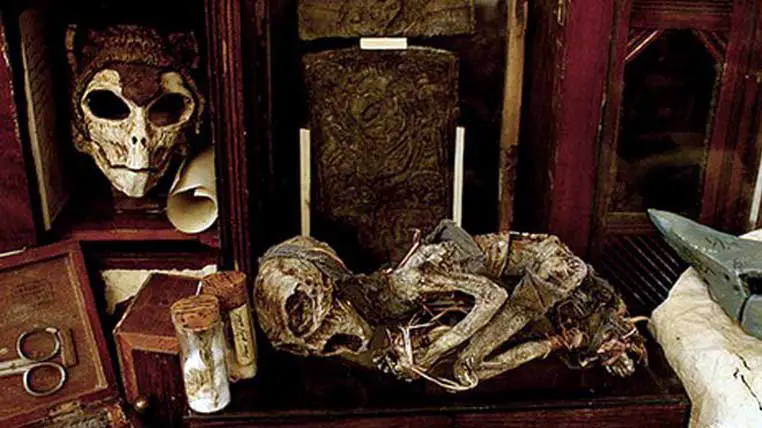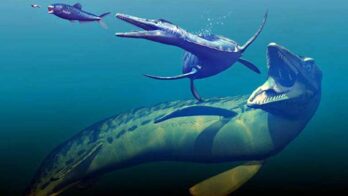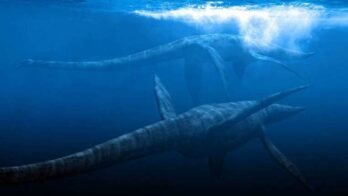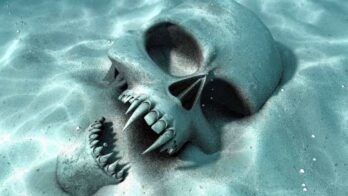Encyclopedia Obscura is part of the Merrylin Cryptid Museum, where it is described as a “repository of arcane knowledge” and notes intended for “scholars, researchers, and collectors of obscure phenomena.”
Generally speaking, Encyclopedia Obscura is a resource for those interested in exploring and researching obscure topics, particularly those related to cryptids, esotericism, and alchemy.
Encyclopedia Obscura's take on the vampire myth
According to Merrylin Cryptid Museum’s Encyclopedia Obscura, werewolves and vampires developed different physical aspects and abilities.
Still, both species retained a common characteristic: they infect their victims with a highly aggressive pathogen capable of modifying and transforming human DNA.
Francis Gerber, a Swiss physicist, botanist, and chemist, published several scientific works dealing with important topics such as the origin of the human species. He began his research around 1776 after buying several specimens of orangutans, chimpanzees, and gorillas.
Gerber dissected and analyzed the animals to find a connection between humans and the higher species of primates.
As expected, his research caused indignation among the scientific community, but this did not stop Gerber from continuing his analyses of species from India, South America, and Africa.
According to Encyclopedia Obscura, on December 14, 1780, Gerber ordered several specimens from the Far East. Along with them, he was also delivered a box containing bone fragments, half a skull, and a mandible.
The mandible caught his attention in a particular way.
The teeth had been extremely well-preserved, and Gerber immediately noticed an unusual characteristic in the studied species: the canine teeth were unusually long and attached to what appeared to be a mummified, flexible muscular structure that allowed the canine teeth to retract inside the mandible.
Mongolian vampires mystery
Encyclopedia Obscura records some of the events that followed Gerber’s discovery.
Concerned about this strange characteristic, Gerber contacted those who had sent him the box with bone fragments.
They told him that the bones had been unearthed near an isolated village on the eastern shore of Lake Baikal in Mongolia.
However, local experts believed it could be a species of monkey, which is why the remains were packaged and shipped to Gerber.
Gerber immediately prepared an expedition whose stated goal was to investigate the possible existence of an undiscovered primate.
He quickly found funding, and the team consisting of Gerber and several other experienced anthropologists and archaeologists arrived in the village indicated by their collaborators from the Far East in the spring of 1781.
Gerber talked to the locals there, who spoke of a mysterious creature they called “The Blood Thief.” For over 100 years, the monster had been terrorizing the region, killing its victims with unprecedented brutality.
Gerber and his team had the opportunity to examine some of the corpses of those killed by “The Blood Thief” and concluded that humans were facing an unknown predator species.
The following 10 years he spent in Mongolia, where he continued to study what he called Homovampyrus.
Gerber was the first to discover a method of studying the behavior of vampire cells when they came into contact with human body cells.
Gerber’s latest journal entries, kept as part of the Encyclopedia Obscura, referred to Thenis, a city built by Homovampyrus more than 40,000 years ago. According to Encyclopedia Obscura, the Swiss researcher discovered concrete evidence of the city’s existence somewhere in the Altai Mountains of Mongolia.
Furthermore, in 1830, Gerber met the son of one of the builders of the city, Damat, the son of Demeclev, a vampire who was 12,000 years old.
Merrylin Cryptid Museum's Encyclopedia Obscura exhibits
Merrylin Cryptid Museum’s Encyclopedia Obscura’s fascinating exhibits consist of over 500 specimens of cryptids, mythical creatures, and other anomalous specimens. The collection is purportedly the life’s work of an 18th-century British naturalist, Thomas Theodore Merrylin.
In addition to the Encyclopedia Obscura, the museum has also featured digital exhibits and virtual tours of the following collections:
The Anomalous Anthropology Collection: Specimens of various human and humanoid anomalies, including deformed skulls, preserved fetuses, and purported evidence of ancient civilizations and lost tribes.
The Cabinet of Curiosities: A collection of strange and exotic objects inspired by the historical tradition of cabinets of curiosities.
The Cryptozoological Society: An exhibit dedicated to the study of cryptozoology, which is the search for creatures whose existence has not been scientifically proven, such as Bigfoot, the Loch Ness Monster, and the Chupacabra. The exhibit includes information about famous cryptozoologists, sightings of cryptids, and theories about their origins.
Collections
Merrylin Cryptid Museum is an unconventional museum in London that exposes science-denied specimens such as preserved remains of fairies, gnomes, dragons, and others.
Here are some of the more interesting Encyclopedia Obscura’s exhibits.
The Mothman
The Mothman is a legendary creature reportedly seen in the Point Pleasant area of West Virginia in the 1960s. The creature is described as having a humanoid body with bat-like wings and glowing red eyes.
The Merrylin Cryptid Museum claims to have a preserved mummified body of the Mothman in its collection, which it describes as a unique and rare specimen.
The Encyclopedia Obscura’s page provides information about the history of the Mothman sightings and presents photographs and illustrations of the creature.
Borrowers and the life cycle of the Faerie
This collection shows the concept of “Borrowers” or “Faeries,” which are small, humanoid creatures that are said to live in the forests and countryside of Europe.
The collection presents illustrations and descriptions of various stages in the alleged life cycle of the Faerie, including the “changeling” phase and the “adult” phase.
According to Merrylin Cryptid Museum’s Encyclopedia Obscura, while observing a group of Larva non Volucris, Thomas Merrylin noticed they were returning from a hunt to their nest.
As he examined the nest, he noticed settled winged homomimus covering it, indicating an impending attack. However, to his surprise, the Larva non Volucris entered a peculiar spout at the base of the nest and vanished, only to reappear an hour later.
During their reappearance, they were seen exchanging pheromones with winged and wingless individuals, including a queen faerie with large wings compared to those around her.
He concluded that the queen was either a newborn ready to establish a new colony or the nest was threatened. The next day, the nest was abandoned, and upon closer inspection, he discovered that the nest was infested with fungal growth, forcing the evacuation.
He followed the group to their new nesting site, where they constructed their new home using a combination of mucus-like excretion and leaf litter for the walls.
The entire hive was engaged in this task, and he studied their construction with great excitement. Unfortunately, upon waking up one morning, he discovered that construction had ceased, and the ground was littered with the bodies of faeries.
They had succumbed to the spores spread by the fungi in their previous nest. Thomas Merrylin collected several of the bodies, which are presented here, providing insight into the life cycle of this species.
Nosferatu
Merrylin Cryptid Museum’s Encyclopedia Obscura’s most famous exhibit is the “Nosferatu” specimen, which is a small, bat-like creature with fur, leathery wings, and fangs.
According to the museum’s website, the specimen was found in a cave in Germany in the early 20th century. The creature has been preserved and is on display at the museum. The website includes several photographs of the specimen, as well as an x-ray and a sketch.
The “Nosferatu” specimen has generated great interest and controversy among cryptozoologists and other enthusiasts of cryptids.
Some believe that the specimen is evidence of the existence of a previously unknown species, while others argue that it is a hoax or a misidentified animal.
The Succubi
One of the most intriguing exhibits in the Merrylin Cryptid Museum is the Succubi, a cryptid with a long and mysterious history.
According to legend, the Succubi are a type of demon or spirit that seduce and prey upon human beings, often appearing in dreams or visions. A Succubi can take on various forms, including those of beautiful women, and have been the subject of many myths and legends throughout history.
At the Merrylin Cryptid Museum, visitors can see a specimen believed to be a physical manifestation of the Succubi. The exhibit is a small, bat-like creature with long claws and fangs, which is said to have been captured in a remote area of Eastern Europe.
The exhibit has generated a great deal of interest and controversy among cryptozoologists and enthusiasts of the paranormal. Some believe that the specimen is proof of the existence of the Succubi, while others argue that it is a hoax or a misidentified animal.
The Henrich Emille Cuboid
Another interesting exhibit, part of the Encyclopedia Obscura’s collection, is the Henrich Emille Cuboid.
In 1280 AD, a monk named Augustine Sera went on a journey to the Amour mountain range to follow the footsteps of the prophet Kalmaridif.
During his journey, he found a series of strange man-made structures carved into the rock of the low-lying cliffs. He found a huge flat facade with a carved staircase at the apex of the passage formed by these cliffs.
The staircase rose halfway up the rock facade to a massive spiral with a 50-foot hole at its center. The monk climbed the stairs and entered the hole, recording his experience in his notes.
Herbert Henrich and Robert Emille, English-born German cousins, found reference to the “doorway” in the pages of the holy texts of the Priory of Ele, a small helvetine conclave in northern Sabha.
They became obsessed with locating this holy shrine and after six years of searching, they eventually discovered it, unseen by human eyes for over 650 years.
Upon entering the doorway, they found a series of rooms with doors carved in spirals. In what appeared to be a central room, they found a passageway lit by unseen sources.
At the foot of the passageway was a strange stone structure with primitive carvings. In the center was a removable rectangular device carved of the same stone, mirroring the crude spiral on the outer facade and concluding with a small hole.
They carefully removed this item from the structure, finding a series of ancient writings scrawled on parchment within its maw.
They then entered the passageway and found that it continued for many miles, vowing to return with more equipment to explore the space more thoroughly.
It is recorded in the Encyclopedia Obscura that Henrich was the first to look within the hole in the rectangular object they removed from the chamber.
The inside space of the object appeared to be larger than the outside, defying all physical laws. The explorers named the device the “Henrich Emille Cuboid,” which became their further research’s focal point.
Upon returning to the United Kingdom, they began piecing together stories of objects and patterns that evoked similar anomalies.
They discovered the research of a German physicist who had discovered a bizarre physical reaction to a fragment of stone found in Cairo, Egypt.
The stone appeared to emit some form of energy or contagion that warped human flesh into conical coils, seemingly bottomless maws that broke open all over the body yet appeared to not harm or cause any ill effect to adults and children alike.
The spiral forms transmuted healthy flesh into stone-like structures, a condition known as Foris spiralis crystallina or Coil Syndrome.
Henrich and Emille found that their cuboid, an imperfect object made of black, unknown rock, mirrored the fragment the late German scientist owned.
The cousins had noticed sores in their skin and limited access to the rectangle, only venturing near it to collect small samples and make three small borings-exploration holes for almost ten years.
Most of the cousins’ work is lost, and Henrich’s small diary is left. From the little that is written, Emille was intrinsically involved until Coil Syndrome affected his newborn son, Frederik.
Emille accused Henrich of deliberately placing Frederik’s cot near the cuboid, but Henrich denied this, and after a time, they returned to work. However, the coil killed Frederik at the age of 11 months.
Who chose to preserve the child’s skull is unknown, but the coil can be seen on its forehead.
Real or hoax?
Merrylin Cryptid Museum is a celebrated museum that boasts an extensive collection of purportedly unidentified creatures and animals, collectively referred to as cryptids.
Cryptozoology aficionados have been enamored with the museum’s offerings for several years now. Among the many enigmatic specimens, the museum houses the “Grendel” skull, the “Siren” mermaid, and the “Mothman” wings, to name a few.
However, despite its allure and sophisticated presentation, the Encyclopedia Obscura collection, featuring prominently in the Merrylin Cryptid Museum, is an elaborate fabrication.
This fictional universe is the brainchild of Alex CF, a prodigious polymath who excels in various disciplines, including writing, illustration, and sculpture.
A resident of London, England, he imbues his works with elements of fantasy and science fiction, and his versatility extends to his musical pursuits, as he fronts several punk and metal bands.
It’s worth noting that he crafted all of the exhibits displayed in the museum.
The museum’s origins are steeped in intrigue, and its contents have generated substantial controversy, yet its popularity among those with an insatiable appetite for cryptids and the unknown remains undiminished.
At Ancient Theory we only use trusted sources to document our articles. Such relevant sources include authentic documents, newspaper and magazine articles, established authors, or reputable websites.
- Historical Hoax: Are These Victorian Artefacts What They Seem? historythings.com.
- Merrylin Cryptid Museum. merrylinmuseum.com. [Source]
- Truth Behind The Viral Story Of Mysterious Skeletons In London Basement. demilked.com.
- Merrylin Cryptid Museum: Proof for the Existence of Mythical Beings or Elaborate Hoaxes? ancient-origins.net.






